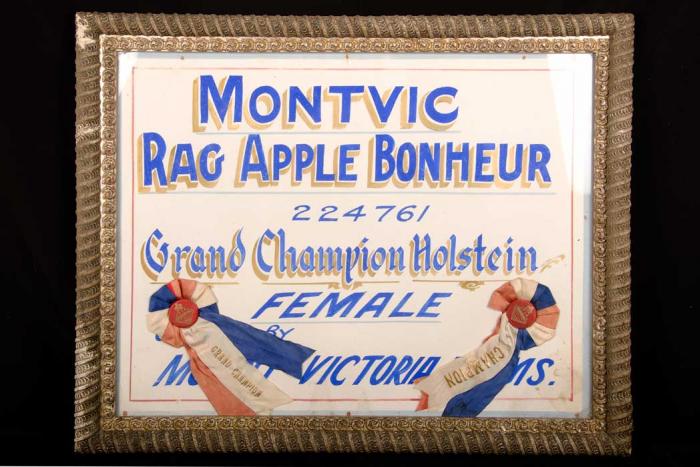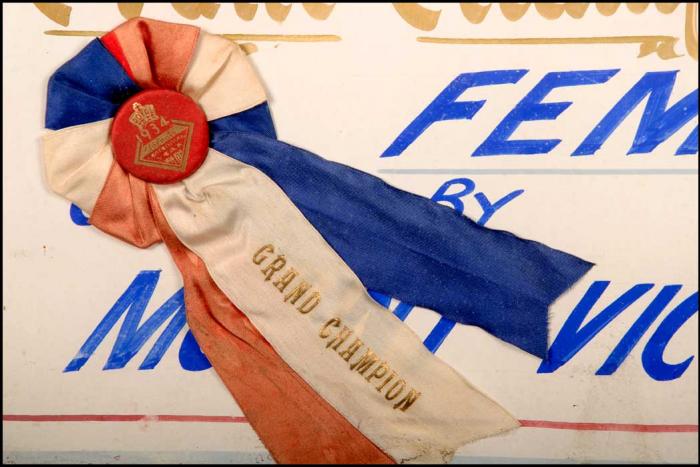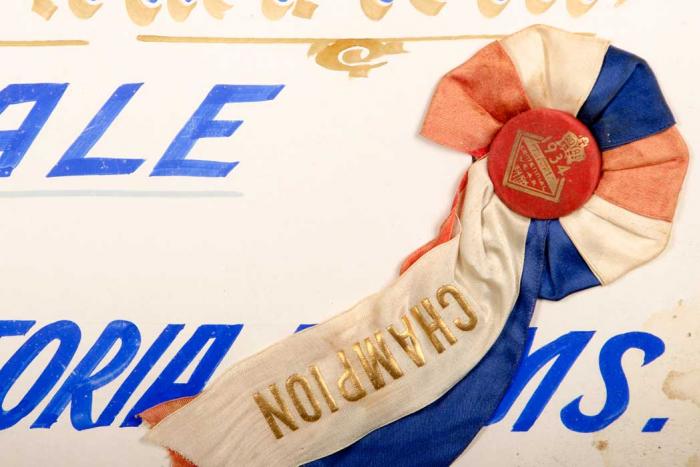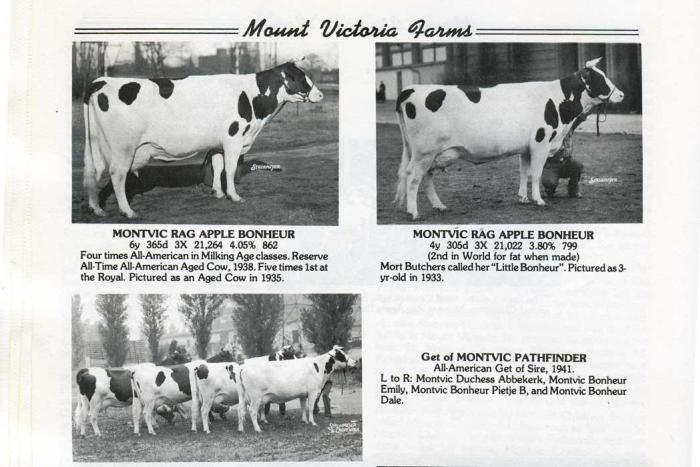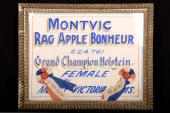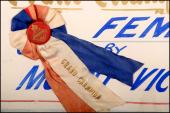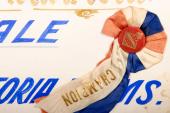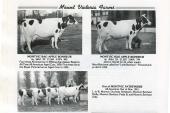Montvic Ribbons
Organization: Hudson Historical Society
Coordinates: www.hudsonhistoricalsociety.ca
Address: 541 rue main Hudson QC J0J 1J0
Region: Montérégie
Contact: Kevin O'Donnell, kevinodonnell46(a)sympatico.ca
Description: Show ribbons awarded to Montvic Rag Apple Bonheur, one of the best cows ever produced in Canada by Mount Victoria Farms of Hudson Heights, Quebec.
Year made: 1934
Made by: Unknown
Materials/Medium: Silk ribbons mounted on paper under glass with a wooden frame
Colours: Red, white blue
Provenance: Royal Winter Fair, Toronto Ontario
Size: Approx. 60 cm x 55 cm, framed
Photos: Rachel Garber. Courtesy Hudson Historical Society
The Show Ribbons of Montvic Rag Apple Bonheur
Kevin O'Donnell
These framed ribbons are among the few objects left to remind us of one of the greatest herds of Holstein cattle of all time – aside from the milk, cheese, ice cream and other dairy products that many millions around the world consume daily. The ribbons were awarded at Toronto’s Royal Agricultural Winter Fair, since 1922 Canada’s most prestigious agricultural event. They were won by Montvic Rag Apple Bonheur, who resided with her bovine kin in Hudson Heights, Quebec.
Who was this regally-named champion? Let’s deconstruct her name.
Montvic
“Montvic” is a contraction of “Mount Victoria Farms,” the legendary agricultural domain founded by Thomas Bassett “T.B.” Macaulay. Macaulay was a cattleman by avocation, an insurance company executive practically by inheritance.
T.B., as he was commonly called, joined the Sun Life Assurance Company of Montreal in 1877, when he was 17. By 20 he was the company actuary. Cynics might credit his rapid rise to his father being president of Sun Life. But in fact T.B. was a leading pioneer in actuarial science, and an innovator in the entire field of insurance – he is a laureate of the insurance Hall of Fame. His biography in the Insurance Hall of Fame reads in part, “Under the direction of T.B. Macaulay, Sun Life began issuing unconditional policies in the 1880s, the first company in the world to remove policy restrictions on travel, occupation, residence and suicide. While initially drawing much criticism from larger and more established companies, the issuing of such policies soon became a worldwide practice.
In the 1890s, married and with five children, Macaulay and family began spending vacation time in Hudson, by then a short train ride from Montreal. After a few years boarding with local farmers or renting a cottage for the summer ($75 for the season, no running water), in 1899 he bought a 300-acre estate in Hudson Heights situated on an escarpment that offered a spectacular view of the Ottawa River. The area had been named Mount Victoria in 1837, in honour of the teenage Queen who had just ascended the throne. The following year the family moved into an Adirondack-style home built from oak logs cut on the property.
It’s easy to label Macaulay as a “gentleman farmer,” but he was no dilettante. One challenge he gave himself was to bring his actuarial insights to the question of breed improvement, and he was successful. His testimonial in the Canadian Agriculture Hall of Fame reads in part, “Mr. Macaulay made a great contribution to agriculture in the selective breeding and in-breeding of corn and carried out extensive experiments with the growing of soy beans under Canadian conditions.”
When the Department of Agriculture decided in 1923 to develop hybrid corn suitable for Canadian growing conditions, a large portion of the germplasm for this work came from Macaulay’s experiments at Mount Victoria Farms. In those days few in Canada appreciated the nutritional and industrial potential of soybeans that included oils and plastics; Macaulay was in correspondence with scientists as far away as the USSR to breed a plant that could thrive in our limited growing season.
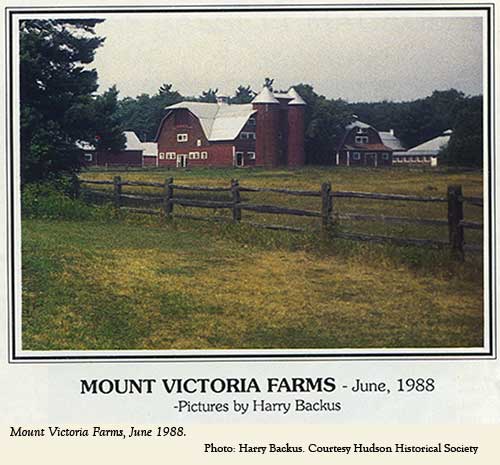
But the soil on Mount Victoria is too sandy for extensive planting of crops, and Macaulay turned his attention to cattle. After preliminary efforts with “Canadienne” cows and milking Shorthorns, by 1924 he had found his animal of choice: Holsteins.
Rag Apple
Holsteins (or Holstein-Friesians) originated in the Netherlands. In the 1880s, over 8,000 head were imported from Europe to North America, with farmers in Ontario and Manitoba purchasing the original Canadian stock. Holstein cows were famous for the large quantities of milk they could produce, one trait that Macaulay appreciated. There was a problem, however: the milk was ‘blue’, or low in butterfat. T.B. set his sights on 4% butterfat, which he felt he could obtain by linebreeding and inbreeding the right animals. He set to work.
In 1924 he purchased his first Holstein cow, Oakhurst Colantha Abbekerk, for $900, a significant sum in those days. Acquiring five more cows, he lay the foundation for his herd with what came to be called the Big Six. But there was one more element of his breeding program he knew he had to put in place. With his knowledge of genetics and by intensive study of trade journals, Macaulay knew that he had to acquire an outstanding bull. Here’s how Horace Backus in his book Mount Victoria Farms and the Montvic Rag Apple Bloodlines described Macaulay’s quest, in language that can be appreciated only by those versed in the language of livestock:
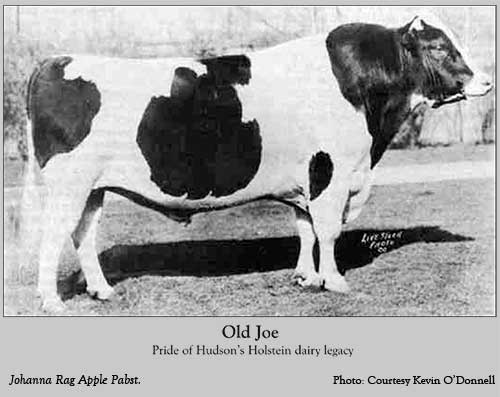
He wanted a ‘name’ bull that had shown well and would continue to show well. He wanted a bull with a good pedigree, particularly for high test on the dam; he would prefer a bull whose pedigree had good linebreeding; and most of all, he wanted a bull that was already ‘proven’ as capable of siring daughters with good udders and 4% test as well as being able to win at the shows. And with all this he would still want the bull to sire the large size and milk yield that had established the Holstein as the dominant dairy breed.
Macaulay looked far and wide for this outstanding animal. His search led him [or rather his assistant Joe Chandler] to a farm in Hartford, Wisconsin. On T.B.’s instructions to pay any price, Chandler handed over the astronomical sum of $15,000 for Johanna Rag Apple Pabst. [The odd choice of a female name for a bull may derive from Countess Johanna, a medieval ruler of Flanders.] And “Old Joe” more than proved his worth. Horace Backus continues:
Mount Victoria’s fortunate selection of Johanna Rag Apple Pabst as the cornerstone for their breeding program succeeded so well that the bloodline resulting from it is known today, not simply as ‘Montvic”, but as ‘Montvic Rag Apple’. The bull and the program became as one.
In the 1926 Royal Winter Fair Johanna Rag Apple Pabst was named Grand Champion Male, with pioneer Oakhurst Colantha Abbekerk winning the prize as Grand Champion Female.
Bonheur
Another of the Big Six that Macaulay purchased in 1925 was called Bonheur Abbekerk Posch 2nd. Naturally this animal was bred with Old Joe, and had three daughters by him. Horace Backus, an American expert on Holstein pedigree, states that “the best known of the three great full sisters became one of the most famous cows of all time, Montvic Rag Apple Bonheur.”
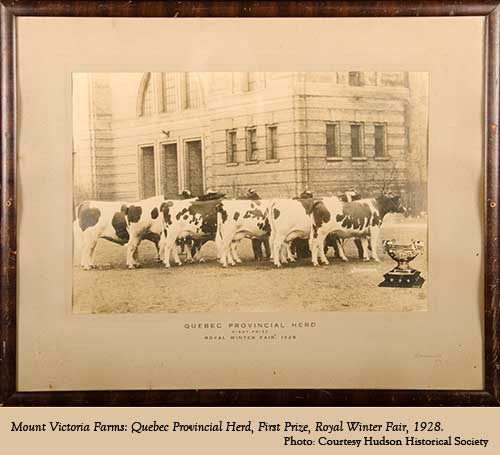
“Little Bonheur” ended up winning Grand Champion Female at the Royal for three years running between 1934 and 1936, as well as other prizes. Not only did she excel at show, she was also a champion in milk production. A rust-coloured binder at the Hudson Historical Society records the statistics of the 153 cows that lived on the farm. In 1936, for example, Montvic Rag Apple Bonheur’s milk production was listed as 21,264 lbs., 862 of fat for an average of 4.05% butterfat, and 365 days in milk. All this while giving birth to twins and travelling to the Royal. The Bullvine, a trade journal, in a recent article noted that she was the “highest producing daughter with a world 3X record of 1,263 lbs of fat” another statistic that will be appreciated by those in the know. Her progeny includes the bull Montvic Pathfinder, of which Backus says, “Many consider his pedigree the greatest ever written.”
The bloodline of Old Joe, little Bonheur and their Mount Victoria Farms kin lives on today. In 1960 the Farmer’s Advocate noted that “two of the largest herds of Canadian Rag Apple cattle in the world – between 1200 and 1500 head - are now in Mexico and Italy. Both herds carry on their registrations in the Canadian Holstein-Friesian herd book.” The article notes that “The Rag Apples are now called the Royal Rag Apples and the line is now distinctly Canadian.” Trudeau International, a livestock sales company, notes that, “Mount Victoria Farms emphasized superior udders and a 4% fat test. The progeny produced from this lineage, known as the Rag Apple Line, is predominant today in Canada.” Others go further. “They say the bloodlines developed by Macaulay have permeated every Holstein pedigree in the world,” Eastern Ontario Agrinews ventured to claim.
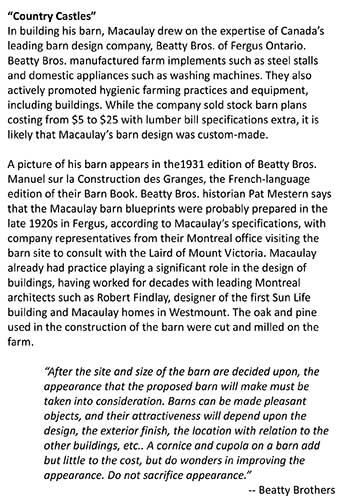
In summing up Macaulay’s accomplishments, The Bullvine is more assertive:
One could easily make the case that T.B. Macaulay and his use of mathematics to develop a line bred bloodline was the greatest cattle breeder of all time. His outstanding collection of Holstein cattle pushed the boundaries of what was considered possible. Macaulay stretched the limits of what was thought achievable. All this from an actuary who loved the artful science of animal breeding!
It would be fitting to conclude this piece by saying that Macaulay’s golden years were spent in tranquillity, basking in his accomplishments in insurance, cattle raising, philanthropy and good works in Montreal and Scotland. But this is not the scenario his life followed.
In 1930, Macaulay made a bullish speech in which he declared, “We believe in the future of Montreal, of New York, of Chicago ...We believe even more in the future of our entire nations, both Canada and the United States. We have hitched our investment policy to the star of this continent.”
But Macaulay had hitched the financial future of Sun Life and of his own personal fortune to a falling star, common stocks.
By the early 1930s Sun Life had become the world’s biggest investor in common stocks and the Great Depression was eating away at the value of the company’s own stock. Shares, which had risen from $560 in 1927 to $4,100 two years later, plunged to $145 following the stock market crash of 1929. Surpluses, which had risen to $60 million in 1929 declined to less than $6 million by 1932.
The International Insurance Hall of Fame delicately observed that, while “(t)he Company achieved great prosperity under Mr. Macaulay’s investment policies, ... the 1929 stock market crash and the Great Depression led Sun Life to re-evaluate its investment practices.” In 1932 Time magazine was less delicate: “…because Mr. Macaulay repeatedly states his belief that 1929 prices will return, much discussion, not all of it complimentary, has centred upon the company and its chief.” One disgruntled policyholder, J.J. Harpell of Ste. Anne de Bellevue alleged that Macaulay was one of the “world’s greatest crooks” on a par with the disgraced Swedish businessman Ivar Kreuger. Macaulay sued for criminal libel and won. Harpell went to jail.
Macaulay retired (or was eased out) as president of Sun Life in 1934 at age 73, retaining with difficulty an honourary position as Chairman Emeritus of the Board. He could no longer afford to maintain his Westmount mansion at 1 Braeside, but did keep his beloved Mount Victoria estate. His Westmount home was eventually incorporated into The Study, an exclusive private school. T.B. Macaulay died at Mount Victoria on April 2, 1942, a little over a month short of his 82nd birthday.
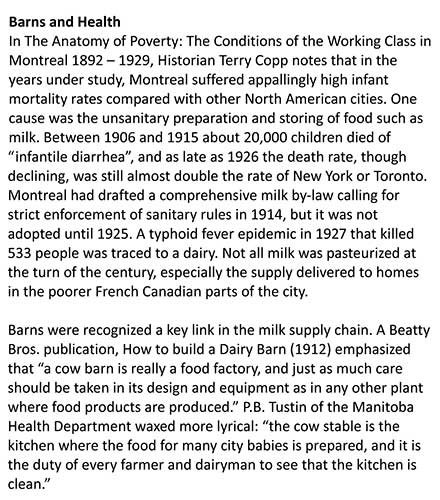
A few months later, though the country was deep in war, Hudson Heights became the centre of the dairy world. Over 2,000 people flocked to the village by the Ottawa River, some arriving in special trains from the United States, some, it was rumoured, coming from as far as South America to attend the Dispersal Sale of the famed Mount Victoria herd of 68 Holsteins. Old Joe had died following an injury in 1933, but many of his progeny would be on the block. A large tent was erected near the barn to provide shelter from the elements. The dairymen bid an average of $1,926 for the animals.
Shortly after that, the farm was acquired by the Norris family and renamed Norfolk Farms. Another cattle breed took the place of the banished Holsteins in the magnificent barn and outbuildings built by Macaulay. Norfolk farms retained a herd of beef cattle into the 1980s, but then after a referendum, the Town of Hudson gave permission for the farm to be turned into a golf course and sub-development. The barn remained, loved by the neighbours and revered by the Holstein cattle people who would regularly visit their “shrine” as one called it.
The barn was knocked down in February 2013. A few days before the heavy equipment made quick work of the old structure, the Eastern Ontario Agrinews noted that, “When it comes to historic monuments, especially those reflecting our agricultural traditions, Canada has too few. Macaulay’s farm would be an obvious one to add to the limited list.” It was not to be.
Sources
T.B. Macaulay and Mount Victoria Farm, http://www.museevirtuel-virtualmuseum.ca/index-eng.jsp
The Farmer’s Advocate,1960
Horace Backus, Mount Victoria Farms and the Montvic Rag Apple Bloodlines: A Personal View, 1988.
Kevin O'Donnell, “The Man behind the Milk: Life and Times of Sun Life Tycoon,” Quebec Heritage News, 2007.
Rag Apple Bonheur, http://www.thebullvine.com/tag/montvic-rag-apple-bonheur/
Eastern Ontario Agrinews, http://www.agrinewsinteractive.com/fullstory.htm?ArticleID=12930&ShowSec...
The Holstein Journal, http://www.holsteinjournal.com/?p=20 http://www.holsteinjournal.com/?p=19
Canadian Agriculture Hall of Fame, http://www.cahfa.com/Home/Inductees/InducteeDetails/tabid/93/ID/8a78d17b...
Insurance Hall of Fame, http://www.insurancehalloffame.org/laureateprofile.php?laureate=48
To Learn More
Peter Lewington, Canada's Holsteins, 1983.
T.B. Macaulay and Mount Victoria Farm, www.hudsonhistoricalsociety.ca
Roderick L. Hodgson, T.B. Macaulay & Mount Victoria Farm. Hudson Historical Society, 1977.
Vaudreuil-Hudson Heritage Trail, www.quebecheritageweb.com/attraction/vaudreuil-hudson-heritage-trail
All-American Holsteins, http://www.dairycowdaily.com/1934-All-American-Holsteins.html
Holstein Canada, www.holstein.ca
Andrew Hunt, “Mount Victoria Farms: the Art and Science of Great Breeding,” http://www.thebullvine.com/breeder-profiles/mount-victoria-farms/
“Holstein: A Love Affair,” http://www.trudintl.com/exportation.php?lg=en
Author
Kevin O’Donnell was elected president of the Quebec Anglophone Heritage Network (QAHN) in June, 2008. QAHN is an association of heritage museums, historical societies and genealogical societies, as well as of libraries, archives, publishing companies and individuals interested in preserving the built, cultural and natural heritage of Quebec. www.qahn.org
While he was president of the Hudson Historical Society (2003 – 2008), he came to realize that heritage in all of its manifestations – not only buildings and landscapes, but also as embodied in stories, in shared experiences and in ways of doing things – is a vital resource for a community to draw upon as it forges its ever-evolving identity. One of his projects was to provide support for Dr. Lambert “Scot” Gardner’s Canada’s Virtual Museum Project, “T.B. Macaulay and Mount Victoria Farm,” which anyone interested in this project should visit: http://www.museevirtuel-virtualmuseum.ca/sgc-cms/histoires_de_chez_nous-...
Kevin has given presentations to numerous historical and heritage associations in the Greater Montreal area, the Townships and in the Outaouais (Western Quebec) region of the province. He has contributed several articles to QAHN’s print magazine, Quebec Heritage News, including three articles on T.B. Macaulay, Mount Victoria Farms and the Barn as a heritage site.


